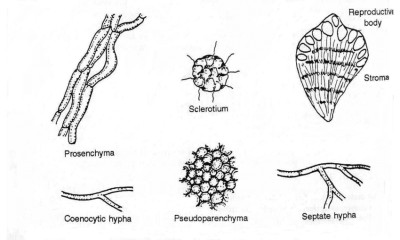General
Characteristics of Fungi
Fungi are
a diverse group of eukaryotic organisms that include yeasts, molds, and
mushrooms. They play crucial roles in decomposition, symbiosis, and disease
causation. The main characteristics of fungi are:
1. Eukaryotic Nature
- Fungi have membrane-bound
organelles, including a nucleus and mitochondria.
- Their genetic material is
enclosed within a nuclear membrane.
2. Heterotrophic Mode of Nutrition
- Fungi lack chlorophyll and
cannot perform photosynthesis.
- They absorb nutrients from
organic matter through extracellular digestion.
3. Cell Wall Composition
- Unlike plants that have
cellulose walls, fungi have chitin in their cell walls, making them
more resistant to environmental stress.
4. Growth Forms
- Unicellular: Yeasts (e.g., Saccharomyces
cerevisiae).
- Multicellular: Molds and mushrooms with
filamentous structures called hyphae.
- Dimorphic Fungi: Some fungi, like Candida
albicans, can switch between yeast and hyphal forms depending on
environmental conditions.
5. Reproduction
- Asexual Reproduction:
- By fragmentation, budding,
or asexual spores (e.g., conidia, sporangiospores, blastospores).
- Sexual Reproduction:
- Involves fusion of gametes
or specialized hyphae, leading to the formation of spores (e.g.,
zygospores, ascospores, basidiospores).
- Spores can be dispersed by
air, water, or animals.
6. Hyphal Structure
- Septate Hyphae: Have cross-walls or septa
(e.g., Aspergillus).
- Coenocytic Hyphae: Lack cross-walls and
contain many nuclei (e.g., Rhizopus).
- Hyphae form a network called
mycelium, which is the vegetative body of fungi.
7. Modes of Nutrition
- Saprophytic: Feed on dead organic
matter (e.g., Penicillium).
- Parasitic: Extract nutrients from
living hosts (e.g., Puccinia, causes rust diseases in plants).
- Mutualistic: Engage in beneficial
relationships (e.g., mycorrhizal fungi enhance plant growth; lichens
involve fungi and algae in symbiosis).
8. Habitat and Distribution
- Fungi thrive in various
environments, including soil, water, decaying matter, and inside living
hosts.
- They can survive extreme
conditions due to their spore-forming ability.
9. Economic and Ecological Importance
- Beneficial Roles:
- Used in medicine (e.g.,
antibiotics like penicillin from Penicillium notatum).
- Play a crucial role in
decomposition, recycling nutrients in ecosystems.
- Used in food production
(e.g., yeast in baking, fermentation in brewing).
- Harmful Effects:
- Cause plant diseases (e.g.,
rusts, smuts, and mildews).
- Some fungi produce toxins
(e.g., aflatoxins from Aspergillus flavus).
- Can cause human infections
(e.g., ringworm, athlete’s foot, candidiasis).
Ainsworth’s
1973 Classification of Fungi
Ainsworth
(1973) classified fungi into several major groups based on morphological and
reproductive characteristics. The classification includes:
Kingdom: Fungi
Subdivision 1: Myxomycota (Slime Molds)
- Lack a true cell wall in
vegetative stages
- Have amoeboid
characteristics
- Class: Myxogastria
- Example: Physarum
Subdivision 2: Mastigomycotina (Zoosporic Fungi)
- Possess motile spores
(zoospores) with flagella
- Found in aquatic
environments
- Class 1: Chytridiomycetes (e.g., Synchytrium)
- Class 2: Oomycetes (e.g., Phytophthora
infestans - late blight of potato)
Subdivision 3: Zygomycotina (Zygospore-forming
Fungi)
- Coenocytic hyphae (aseptate)
- Sexual reproduction through
zygospores
- Class: Zygomycetes
- Order: Mucorales (e.g., Rhizopus
stolonifer - black bread mold)
- Order: Entomophthorales
(e.g., Entomophthora)
Subdivision 4: Ascomycotina (Sac Fungi)
- Produce ascospores inside an
ascus
- Largest fungal group
- Class: Ascomycetes
- Order: Saccharomycetales
(e.g., Saccharomyces cerevisiae - yeast)
- Order: Eurotiales (e.g., Aspergillus,
Penicillium)
- Order: Hypocreales (e.g., Fusarium)
Subdivision 5: Basidiomycotina (Club Fungi)
- Spores (basidiospores)
produced on a basidium
- Include mushrooms and rust
fungi
- Class: Basidiomycetes
- Order: Agaricales (e.g., Agaricus
bisporus - edible mushroom)
- Order: Uredinales (e.g., Puccinia
graminis - wheat rust)
- Order: Ustilaginales (e.g.,
Ustilago - smut fungi)
Subdivision 6: Deuteromycotina (Fungi Imperfecti)
- No known sexual stage
- Includes many pathogenic
fungi
- Class: Deuteromycetes
- Order: Moniliales (e.g., Alternaria,
Fusarium)
- Order: Sphaeropsidales
(e.g., Phoma)
Diagram: Ainsworth’s fungal
classification tree structure
This
classification provides a structured understanding of fungal diversity. Now, I
will prepare a PowerPoint presentation summarizing these points with labeled
diagrams.
Kingdom: Fungi
Subdivision 1: Myxomycota (Slime Molds)
- Class: Myxogastria
- Example: Physarum
Subdivision 2: Mastigomycotina (Zoosporic Fungi)
- Class 1: Chytridiomycetes (e.g., Synchytrium)
- Class 2: Oomycetes (e.g., Phytophthora
infestans - late blight of potato)
Subdivision 3: Zygomycotina (Zygospore-forming
Fungi)
- Class: Zygomycetes
- Order: Mucorales (e.g., Rhizopus
stolonifer - black bread mold)
- Order: Entomophthorales
(e.g., Entomophthora)
Subdivision 4: Ascomycotina (Sac Fungi)
- Class: Ascomycetes
- Order: Saccharomycetales
(e.g., Saccharomyces cerevisiae - yeast)
- Order: Eurotiales (e.g., Aspergillus,
Penicillium)
- Order: Hypocreales (e.g., Fusarium)
Subdivision 5: Basidiomycotina (Club Fungi)
- Class: Basidiomycetes
- Order: Agaricales (e.g., Agaricus
bisporus - edible mushroom)
- Order: Uredinales (e.g., Puccinia
graminis - wheat rust)
- Order: Ustilaginales (e.g.,
Ustilago - smut fungi)
Subdivision 6: Deuteromycotina (Fungi Imperfecti)
- Class: Deuteromycetes
- Order: Moniliales (e.g., Alternaria,
Fusarium)
- Order: Sphaeropsidales
(e.g., Phoma)
What will i learn?
- On completion of this course students will be able to:. Distinguish the characteristics of different groups of fungi. Understand the mode of thallus nutrition and reproduction.


Write a public review